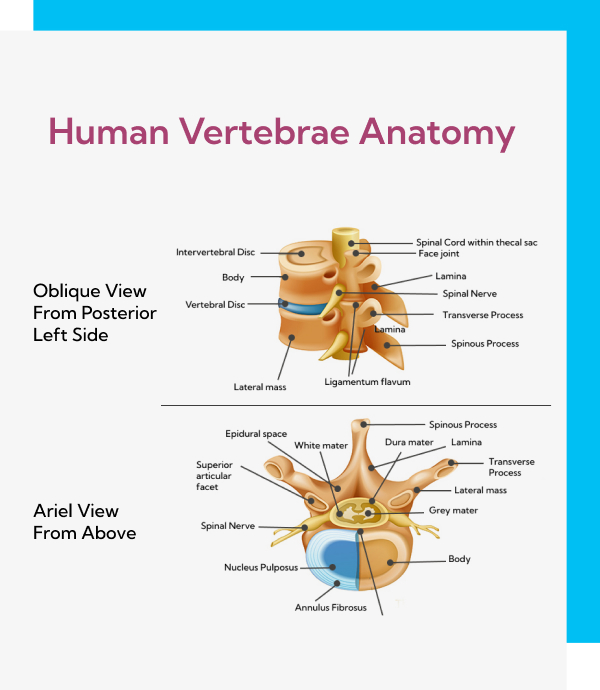The neck is an intricately structured column connecting the head with the rest of the body. Anatomy-wise, it is a part of your backbone or spinal column which starts from the base of your skull and extends to your lower back.
The neck is an intricately structured column connecting the head with the rest of the body. Anatomy-wise, it is a part of your backbone or spinal column which starts from the base of your skull and extends to your lower back.

The region of the spine encompassing the neck is commonly referred to as the cervical spine. This section comprises 7 bones scientifically designated as C1 to C7 vertebrae. Intervertebral discs, situated between each vertebra, absorb shock, ensuring the protection of the spine and enabling seamless movement.
The spinal column comprises individual vertebrae, forming an arched structure collectively known as the spinal canal. Within this elongated hollow space, essential nerves and the fragile, wand-like spinal cord are housed.
The brain and spinal cord comprise the body’s central nervous system. This delicate structure is surrounded by cerebrospinal fluid (CSF). It is enclosed within a three-layered protective membrane called the arachnoid, pia, and dura mater. Collectively, these membranes are called the meninges. The muscles and ligaments attached to the vertebrae provide an extra blanket of protection and support for this delicate system.
Each spinal vertebra is associated with a spinal nerve pair that exits through tiny openings known as foraminae. These spinal nerves play a crucial role in transmitting messages to and from the brain through the spinal cord, thereby facilitating sensations and controlling the movement of various sections of the body.
This spinal condition occurs due to the narrowing of the spinal canal, leading to compression of the spinal cord. It compresses the adjacent nerves as well. The development of this condition is often associated with age-related processes within the body.
Such progressive spinal degenerations cause mild to severe Cervical Stenosis. Mild stenosis can be managed conservatively if symptoms are limited to neck pain. For severe cases, it is best to consult with our neurosurgeons.
It is best to consult your specialist at Sri Balaji Hospital if you experience any of the following symptoms:
If your symptoms are severe, it is best to consult your general physician or neurosurgeon at Sri Balaji Hospitals. However, we urge you to seek prompt medical care in case of a sudden weakness that does not disappear. Such situations are emergencies, and any delay can cause permanent neurological damage. Kindly consult a spine care specialist for the symptoms that gradually appear.
Accurate diagnosis is critical in drafting your Cervical Stenosis treatment. Our specialists will evaluate your medical history and symptoms and recommend the necessary tests to diagnose your condition. Furthermore, it is also crucial to correlate the diagnostic results with your symptoms since spinal degeneration and arthritis are common age-related factors. Our doctors may suggest:
The CT scan reveals bone-related abnormalities like osteophytes, bone spurs, damages and bone fusion due to infection or tumour. The computer-generated diagnostic image combines thin-cut X-rays showcasing the spinal canal, surrounding structures, and bones.
To assess nerve damage, electromyography (EMG) and nerve conduction studies (NCS) measure electrical impulses along peripheral nerves, muscle tissues, and nerve roots. These tests also provide insights into whether nerves are recovering from compression or past injuries.
As suggested by its name, the MRI (magnetic resonance imaging) scan employs strong magnets and advanced technology to detect infections, herniations, tumours, swellings, and indications of spinal cord degeneration in surrounding tissues and nerve roots.
A myelogram is a diagnostic imaging procedure utilizing the spinal canal’s X-rays, enhanced with contrast dye. This technique is employed to unveil conditions such as herniated discs, tumours, or bone spurs that exert pressure on the nerves or spinal cord.
When none of the above measures delivers the desired results, our doctors may suggest cervical stenosis surgery in case of:
Despite several surgical options to treating Cervical Stenosis, our doctors will recommend what’s most appropriate for your condition based on your diagnostic results.
Regardless of the approach, our surgical objectives are all about:
Our specialists may recommend spinal fusion to bolster spinal stability and alleviate chronic neck pain. The procedure fuses multiple cervical vertebrae with plates or screws to provide support to the weak cervical spine.
The primary goal of an Anterior Cervical Discectomy (ACD) is to address nerve compression and alleviate associated pain and discomfort. This minimally invasive procedure involves a small incision in the front of the neck, with the type of incision depending on the extent of the disc repair:
Following the incision, the surgeon gently separates the soft tissues of the neck to access the affected area. The intervertebral disc and bone spurs are removed, and the spinal cord and nerve roots are decompressed. To fill the void between the vertebrae, a small piece of bone or a device is inserted. Over time, the vertebrae naturally fuse, bridging the gap and promoting long-term stability.
In cases where cervical stenosis is attributed to bone spurs, our medical professionals may recommend a corpectomy as an alternative to discectomy, as it effectively addresses the presence of spurs. This surgical procedure involves the removal of a portion or the entire vertebral body itself to alleviate pressure on the spinal cord. In advanced cases of the disease, multiple vertebral bodies and adjacent discs may be removed.
As part of the corpectomy procedure, spinal fusion is often performed. This entails using a small piece of bone or a device to fill the space between the vertebrae. Recovery from corpectomy may take longer compared to anterior cervical discectomy due to the greater amount of bone removed. Depending on the extent of spinal reconstruction required, your surgeon may choose to reinforce the anterior construct with posterior instrumentation and fusion for added support.
Posterior Microdiscectomy is a surgical intervention designed to address substantial soft disc herniation situated on either side of the spinal cord. As indicated by its name, this procedure is conducted on the posterior aspect of the neck. A small incision is made through which a high-speed burr is inserted. This burr removes the facet joints, exposing the nerve root beneath. Throughout the surgery, the nerve root is delicately repositioned to facilitate the removal of the disc herniation.
Posterior cervical laminectomy and fusion is a surgical procedure designed to relieve pressure on the spinal cord and nerve roots. The surgeon makes a small incision in the central region of the back of the neck to remove the lamina, spurs, disc material, or thickened ligament responsible for the issue. Additionally, if needed, the foramen—the passageway in the vertebrae through which spinal nerve roots travel—is widened to accommodate the nerves effectively. In cases of significant degeneration, a posterior spinal fusion may be recommended in conjunction with the laminectomy to ensure proper spinal stability and alignment.
